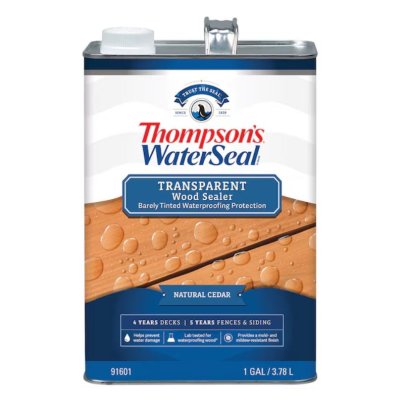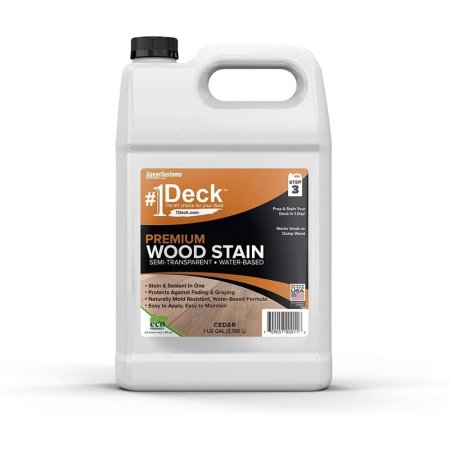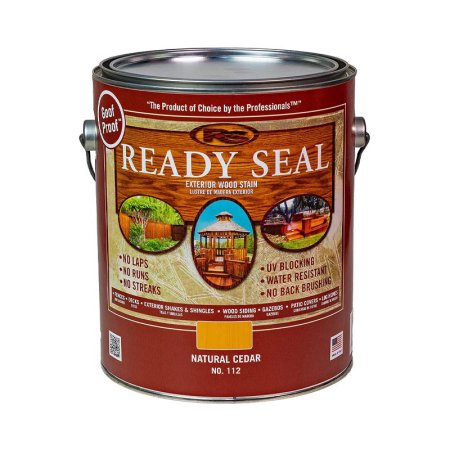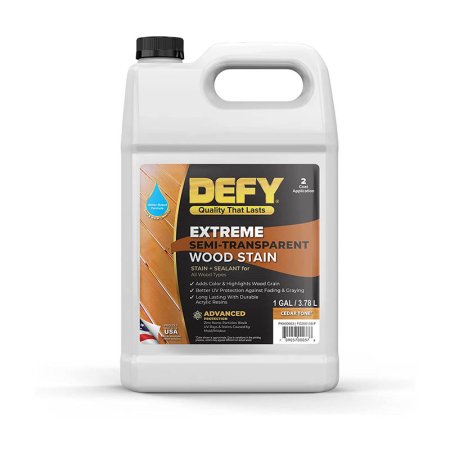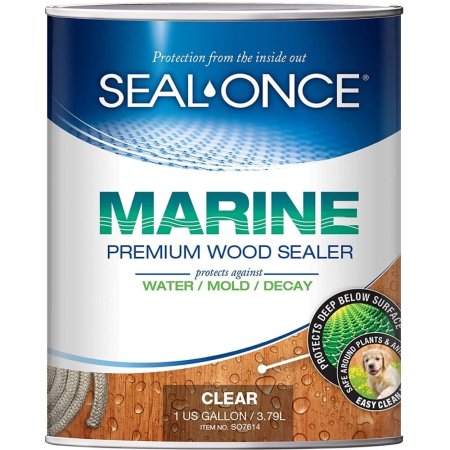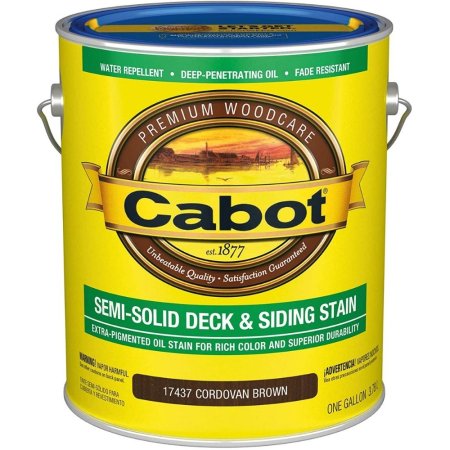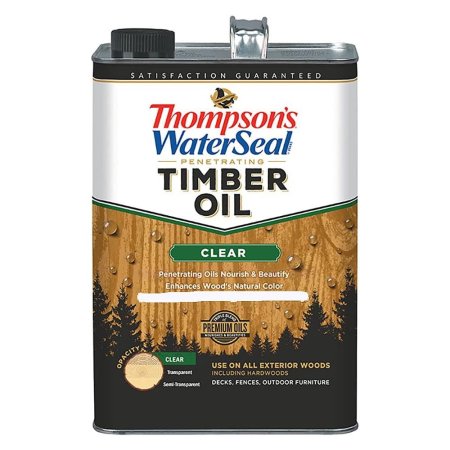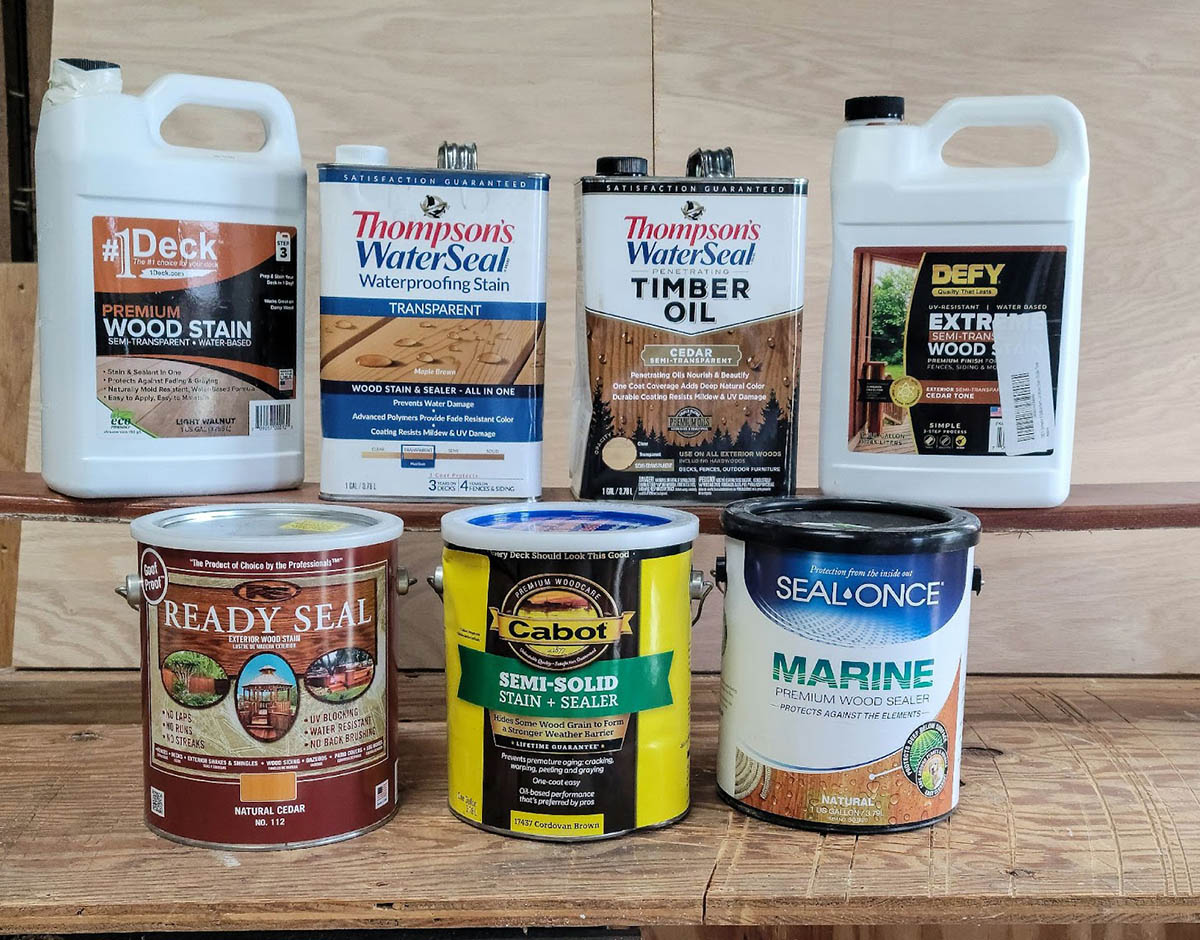
We may earn revenue from the products available on this page and participate in affiliate programs. Learn More ›
Harsh ultraviolet (UV) rays, battering rain, and temperature extremes can take a toll on a wood deck, leaving it faded and dull. Staining a deck with a quality product can help revive its appearance while adding a measure of protection against the elements. What makes one deck stain superior to another? That’s what I wanted to know, so I tested several of the top products on actual decking boards.
I discovered there’s more to wood deck stain products than I imagined. Some offer just a hint of color, while others virtually obscure the wood grain. Others offer mildew or UV protection and are less likely to fade over time, while some emit toxic fumes during application. Outdoor living area specialist Rafi Friedman, president of Coastal Luxury Outdoors based in Jacksonville, Florida, also gave us some things to think about when choosing a product.
Keep reading to learn about the different types and what to look for when choosing the best deck stain for your exterior wood structure. Then, check out the following products, which all earned a spot in this lineup by performing well in the tests.
- BEST OVERALL: Thompson’s WaterSeal Transparent Waterproofing Stain
- BEST BANG FOR THE BUCK: SaverSystems #1 Deck Premium Semi-Transparent Stain
- BEST FOR NEW DECKS: Ready Seal Wood Stain and Sealer
- BEST FOR PRESSURE-TREATED: Defy Extreme Semi-Transparent Wood Stain
- BEST WATER PROTECTION: Seal-Once Marine Premium Wood Sealer
- BEST SEMI-SOLID: Cabot Semi-Solid Deck & Siding Stain
- BEST FOR OLD DECKS: Thompson’s WaterSeal Penetrating Timber Oil
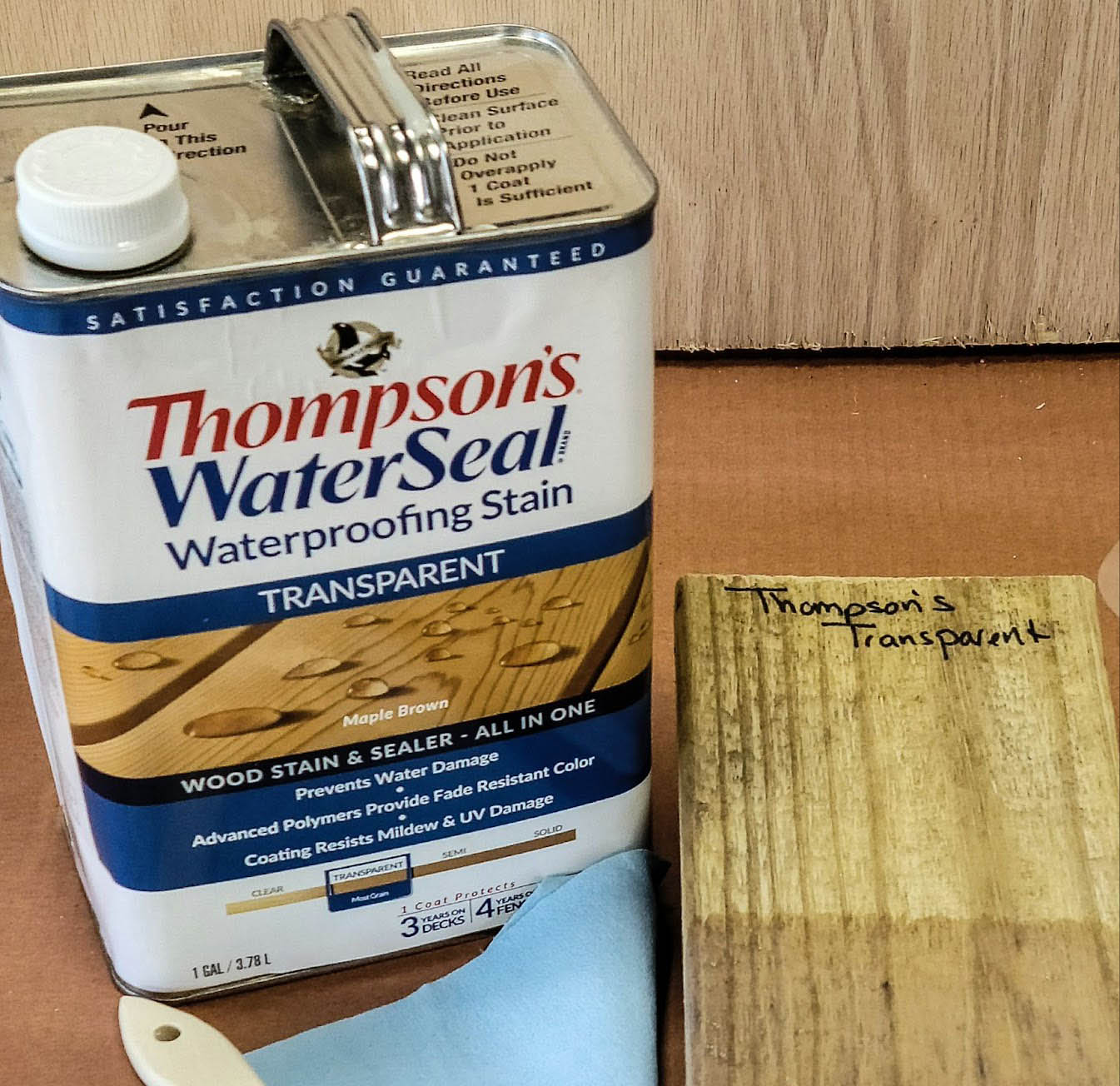
Before You Buy Deck Stain
There’s a fine line between painting vs. staining a deck. The two products—paint and stain—are comparable and contain many of the same ingredients. Stain is transparent and should still show the wood grain; however, paint covers and completely obscures the wood.
Both products help preserve wood by repelling water and, depending on the brand, often include UV blockers and mildewcide to prevent mold and mildew growth.
Friedman shares his expert advice on maximizing your results when applying a deck stain: “One of the big mistakes I see is people applying stain unevenly. It’s best to go one even coat at a time, even if the first coat doesn’t seem dark enough.” He says that this could mean taking multiple days to stain your deck, but the results will absolutely be worth it.
How We Tested the Best Deck Stains
My primary goal in testing today’s top wood stain products was to determine how much they could enhance the look of natural wood and whether they offered protection against moisture. I was also interested in whether they emitted toxic fumes and how well their colors held up to harsh sunrays and the elements.
I applied each of the stains to new decking boards with a brush and then put them outdoors when they were fully dry. Each board was left out in the rain and sun for 3 weeks. After that, I sprayed each board with a hose to find out if the stained section of the board would absorb water.
To see whether it looked faded or fresh, I closely inspected the color of the stain. It would have been nice to be able to leave the boards outdoors for a whole year, but I only had 3 weeks to test them.
Each of the deck stains was scored using a rubric, and I awarded points based on how easy the products were to apply, how well they enhanced (or hid) the wood grain, and their overall water-resistance factor. At the end of the testing, I added the points and used them to determine the best category for each of the products.
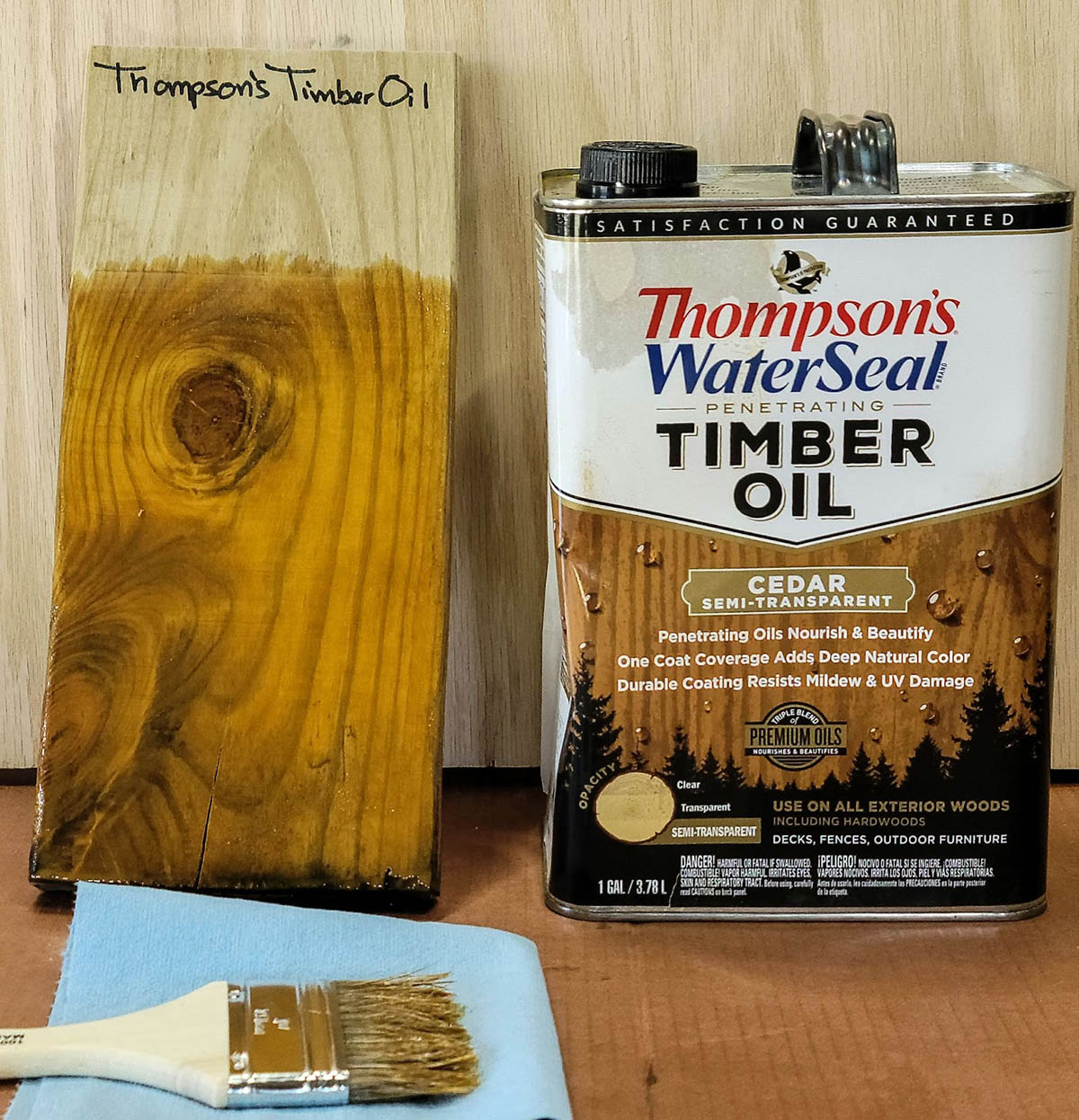
Testing Stats
Products tested: 7
Hours spent testing: 50
Tests performed: 2 to 3
Average price: $40 per gallon
Our Top Picks
As part of my testing, I looked for stains that impart a natural-looking tone that enhance the deck’s look while also protecting the wood. The color tones could be light or dark, as long as they looked like natural wood. I also looked for products that were easy to apply and provided uniform coverage.
While choosing a deck color is a matter of preference, the product should go on uniformly and leave the deck looking fresh, natural, and new. These deck stain products differ in type and hue, but each is well suited for staining various kinds of wood decking.
Best Overall
Thompson’s WaterSeal Transparent Waterproofing Stain
Pros
- A slight color tint is left behind to add a fresh look to decking or wood
- Wood sealer that’s included with purchase keeps decking looking new
- The fade-resistant formula lasts for years to come
Cons
- Slightly watery; it may be messy to apply with a brush
Product Specs
- Base type: Water-based
- Opacity: Transparent
- Wood compatibility: Softwoods (pressure-treated pine, cedar, fir, and redwood)
Our Ratings: Color 5/5; Drying Time 5/5; Ease of Application 4/5; Value 5/5
I tested Thompson’s WaterSeal transparent waterproofing stain in maple brown by brushing it on a test board cut from a piece of standard decking. (Since I tested this product, Thompson’s has updated the look of the bottle and the name of the product and stain, though the formula is the same. It’s now known as Thompson’s WaterSeal Transparent Wood Sealer in Desert Tan.) The stain didn’t add much color; instead, it simply helped balance the dark and light tones so they looked more uniform with less contrast.
The stain was easy to apply with a brush, but it’s on the runny side. If I had to stain an entire deck, I’d probably use an airless spray rig to apply it.
Although this stain also contains a sealer, it didn’t create a noticeable film on the board’s surface; in fact, it left no sheen at all. The most significant benefit I could see was that this transparent stain would create a more uniform look on a deck if some boards were slightly lighter or darker—it would even out the tones—but not much more.
After the stain dried completely (24 hours), I set the test board outdoors to expose it to the sun and the elements for 3 weeks. After its time outdoors, I tested the board for moisture resistance by spraying it with water. The water beaded up and ran off, and the color still looked as good as it did when I first applied the product. I recommend this stain for those looking to protect a deck without noticeably changing its look.
Get the Thompson’s waterproofing deck stain at Lowe’s or Ace Hardware.
Best Bang for the Buck
SaverSystems #1 Deck Premium Semi-Transparent Stain
Pros
- Both a stain and sealer; all products required for staining in one
- Formula is low in volatile organic compounds (VOCs); ideal for those who love eco-friendly or low-chemical products
- Can be applied on damp wood; ideal for those who live in moist environments
- Comes in multiple wood tones to suit the user’s preferences
Cons
- Color might be less uniform on hardwoods such as fir
Product Specs
- Base type: Water-based
- Opacity: Semitransparent stain
- Wood compatibility: Softwoods
Our Ratings: Color 4/5; Drying Time 4/5; Ease of Application 4/5; Value 4/5
Don’t spend a lot on a deck stain. You can give any wood deck an updated look with SaverSystems #1 Deck Premium wood stain, which is available in a handful of rich, semi-transparent stains. This stain-and-sealant combo protects wood from fading and graying while imparting a natural wood tone. It can give an old, weathered deck a fresh new look while providing moisture-resistant qualities.
I tested #1 Deck in an attractive light walnut tone, and I applied it to a decking board with a brush. It went on smoothly and uniformly, bringing out a rich tone in the wood. The manufacturer suggested applying two coats, so I did. The second coat deepened the color even more.
After 24 hours, I set the test board outdoors and left it there for 3 weeks. At the end of that time, I sprayed water on the board to see whether it would repel water. It did, and the water beaded up and ran off. The color was still deep and rich.
The product is suitable for use on all softwoods, but the manufacturer suggests letting high-oil softwoods, such as redwood or cedar, age a minimum of 1 year before applying #1 Deck. This gives the natural oils a chance to dissipate, so they don’t interfere with stain absorption.
Get the SaverSystems deck stain at Amazon or Walmart.
Best for New Decks
Ready Seal Wood Stain and Sealer
Pros
- Comes in multiple hues and finishes to suit multiple user preferences
- Extremely weather-resistant; resists UV rays, mildew, moisture, and fading
- Both stain and sealer in one product for ample convenience
Cons
- May require thinner or solvent after application
- Emits fumes during the application process
- Longer dry time of 72 hours
Product Specs
- Base type: Oil-based
- Opacity: Semitransparent stain
- Wood compatibility: Most common exterior wood types
Our Ratings: Color 4/5; Drying Time 2/5; Ease of Application 3/5; Value 4/5
Protect a new deck from the get-go with Ready Seal wood stain and sealer. Its efficient two-in-one application is a time-saver, and the product comes in a selection of rich, wood-toned colors. This oil-based, semi-transparent stain penetrates the wood for deep protection yet allows the wood grain to show. It contains UV blockers to prevent fading and resists mold and mildew growth.
I selected a natural cedar color to test Ready Seal, and it went on smoothly with a brush. It added a rich golden hue to the wood and a slight sheen. As an oil-based product, it did emit fumes, so I had to open a window for ventilation. If applying it outdoors to an entire deck, the fumes would likely not be an issue.
I had to wait a full 72 hours for the test board to dry before putting it outdoors. After that, it spent 3 weeks in the sun and rain. When I tested the board for water resistance, it performed well; the water beaded up and ran off. The color was still deep and rich, and the surface had a bit of a pleasing sheen.
Apply this penetrating stain/sealer combo by brush, roller, or sprayer. However, because the product is oil-based, cleanup of tools requires paint thinner or another solvent. Ready Seal is well suited for new treated-wood decks, but users should wait 6 months after the deck’s construction to allow the treatment chemicals to evaporate.
Get Ready Seal deck stain at Amazon, Lowe’s (5 gallons), Ace Hardware (5 gallons), The Home Depot, or Walmart.
Best for Pressure-Treated
Defy Extreme Semi-Transparent Wood Stain
Pros
- Comes in multiple finishes to suit a user’s preferences
- Low-VOC formula; ideal for those who like low-chemical products
- Lasts 1 year to 2 years longer than similar stains; made with UV and mold/mildew protection
- Large quantity can accommodate multiple or large-scale use
Cons
- Allow 6 months before applying to pressure-treated wood
Product Specs
- Base type: Water-based
- Opacity: Semitransparent stain
- Wood compatibility: Most common exterior wood types
Our Ratings: Color 4/5; Drying Time 4/5; Ease of Application 4/5; Value 4/5
A pressure-treated wood deck can look worn or exhibit a slightly green tinge, but Defy Extreme wood stain can change that. This semitransparent stain is available in a selection of realistic-looking wood tones that impart rich, uniform color while still allowing the wood’s natural grain to show. The new tone can counteract the greenish hue that often lingers on pressure-treated lumber.
I chose a natural cedar tone and applied it with a brush. It went on smoothly and penetrated quickly, and the product was wonderfully free of fumes. The warm golden tone neutralized the slightly green hue on the test board. In 24 hours, the board was fully dry and ready to go outdoors to weather the elements.
The product contains ingredients that block harmful UV rays to keep the stain from fading, so I wasn’t surprised to find the color looking just as fresh after its time in the sun as when I applied it. The water beaded up and ran off, so it also passed the water-resistance test.
However, the manufacturer does not recommend applying this stain to newly built decks if they’re made from pressure-treated wood. Instead, they recommend waiting 6 months to allow the chemicals in the wood to dissipate so they don’t interfere with the uniform absorption of the stain.
Get the Defy deck stain at Amazon or Walmart.
Best Water Protection
Seal-Once Marine Premium Wood Sealer
Pros
- Suitable for wet climates; ideal for those that live in moist environments or near bodies of water
- Low-VOC formula; ideal for those that prefer eco-friendly or low-chemical products
- Transparent formula protects wood without changing its appearance
Cons
- Pressure-treated lumber must be dry before applying
Product Specs
- Base type: Water-based
- Opacity: Transparent stain
- Wood compatibility: Most common exterior wood types
Our Ratings: Color 4/5; Drying Time 4/5; Ease of Application 4/5; Value 4/5
The word “marine” in the title gives this stain/sealer combo away—it offers a high level of protection for decks that are regularly exposed to humidity and moisture. It’s even designed to prevent water damage in areas near saltwater.
When I opened the can, the first thing I noticed was the lack of toxic fumes. After testing a couple of other stains with fumes strong enough to give me a headache, this was a nice feature. I applied the stain/sealer product with a brush, and it barely changed the look of the wood. I’d selected “Natural” as the tone, and while it looked yellow in the can, the color didn’t transfer to my test board. I could barely tell any difference.
After allowing the board to dry for 24 hours, I put it outdoors to weather the elements. After 3 weeks, after testing the board for water resistance, it passed with flying colors—the water beaded up and ran off. I could see just a bit of a color difference where I’d applied the stain, but not much. For someone who wants to retain the most natural look of their deck while adding a level of moisture protection, Seal-Once Marine is a decent option.
Get the Seal-Once deck stain at Amazon, The Home Depot, or Walmart.
Best Semi-Solid
Cabot Semi-Solid Deck & Siding Stain
Pros
- Heavy-duty formula; suitable for heavy-duty re-staining projects
- Fade- and corrosion-resistant formula lasts for years after application
- Comes in multiple finishes to satisfy multiple users’ preferences
- Requires a single-coat application for ample user-friendliness
Cons
- Obscures much of the existing wood grain
Product Specs
- Base type: Oil-based
- Opacity: Semi-opaque/semi-solid deck stain
- Wood compatibility: Most common exterior wood types
Our Ratings: Color 3/5; Drying Time 4/5; Ease of Application 4/5; Value 4/5
Cabot’s Semi-Solid stain is a worthy option for a deck with mismatched boards or one that requires a complete change of color. The high pigment level in this oil-based formula offers superior coverage paired with UV protection to camouflage imperfections.
I used a brush to apply this semi-solid deck stain, and the test board immediately took on a deep, dark tone. Unlike the other stains I tested, this semi-solid Cabot product obscured much of the wood grain. What it didn’t hide, it enhanced. I chose cordovan brown, which is a very deep shade of brown. However, the product is available in lighter wood tones.
This product is low in VOCs, so I didn’t detect any fumes. The color is so rich—a single coat of this stain is all that’s necessary to refresh a deck that needs a pick-me-up. After the test board remained outdoors for 3 weeks, the tone was just as rich and dark as ever, and it repelled water well. This stain is well suited for updating a deck with boards that don’t match since it can cover much of the wood grain and add a uniform color.
Get the Cabot deck stain at Amazon, Lowe’s, or Walmart.
Best for Old Decks
Thompson’s WaterSeal Penetrating Timber Oil
Pros
- Both stain and sealer in 1 product for convenience; only requires 1 coat
- Comes in multiple wood tones to suit many users’ preferences
- Protects wood against weathering over time; comes with excellent water damage protection
Cons
- Mineral spirits or paint thinner needed for cleanup
- Toxic fumes may be emitted during the application process
Product Specs
- Base type: Oil-based
- Opacity: Semitransparent stain
- Wood compatibility: Softwoods or hardwoods
Our Ratings: Color 4/5; Drying Time 4/5; Ease of Application 3/5; Value 4/5
Brushing on a coat of Thompson’s WaterSeal Penetrating Timber Oil reminded me of dusting wood furniture with an oil-based protectant—it brought out the wood’s color and added a layer of sheen. This is an oil-based product, so it does have an odor. I had to open a window when applying it to the test board.
The product soaked in quickly, and while it brought out the natural wood grain, it didn’t obscure it; instead, it enhanced it. (I chose a cedar tone, but various tones are available.) I applied only one coat, as recommended by the manufacturer. After 24 hours it was fully dry, and I placed the test board outdoors to face the sun and the elements for 3 weeks.
When the time was up, I sprayed the board with a hose, and the water beaded up and ran off. The color was still nice and rich. In addition to the application odor, a downside in using this oil-based stain is that brushes, rollers, or sprayers must be cleaned with mineral spirits or paint thinner.
Timber Oil adds a lot of protection to wood decking, making it especially suitable for updating older decks that have lost most of their natural oils to evaporation.
Get Thompson’s penetrating deck stain at Amazon or Lowe’s.
Jump to Our Top Picks
What to Consider When Choosing a Deck Stain
Choosing a wood deck stain is about more than just picking a color and brushing the product on the decking. First, consider the type and age of the deck wood and whether it’s been previously stained or painted. In addition to updating the appearance, the best deck stain often provides a measure of protection against foot traffic and the elements.
Base
Deck stains come in two main types: oil-based (alkyd) and water-based. Both stains are applied in a similar manner and are available in a range of attractive wood-tone shades, including colors that mimic redwood, cedar, and mahogany. Still, while similar, each type has some specific benefits and considerations.
- Oil-based deck stains, which have been around for decades, do an excellent job of protecting exterior wood. Oil-based stains:
- Naturally repel water and reduce the risk of mold growth.
- Penetrate the wood grain.
- Condition wood to help prevent warping and cracking.
- Can take up to 48 hours to dry after application.
- Cost less than most acrylic-based stains.
- Usually require strong-smelling solvent, such as paint thinner, to clean brushes and paint sprayers after use.
- Moreover, oil-based stains are flammable when wet. Both the liquid and fumes can ignite, so refrain from smoking and stay away from an open flame when applying the stain. Once dry, oil-based stains no longer pose a fire hazard.
- Water-based stains are relatively new but becoming increasingly popular. These stains use water as their base. Water-based stains:
- Clean up easily with soap and water
- Dry quickly, often within 2 to 3 hours
- Sit on top of the wood instead of penetrating the grain
- Usually cost more than oil-based stains
- Register lower in volatile organic chemicals (VOCs), so they are more environmentally friendly and create fewer fumes than oil-based deck stains
Opacity
The opacity of wood stains—their degree of transparency or opaqueness—determines the finished look and affects how well the product can protect the deck. Deck stain is available in four opacities:
- Toner: This stain is closest to a clear sealer. It contains just a hint of color and imparts only a slight hue to the wood that won’t change the deck’s overall look. For the best protection, toner must be reapplied every year.
- Semitransparent: As the most popular opacity level, semitransparent stains add noticeable color to the deck, but the wood grain still shows. They offer some deck sealer protection, but plan to recoat every 2 to 3 years.
- Semi-opaque: Also called “semi-solid,” this deck stain contains enough pigment to obscure most of the wood grain while imparting rich color. Users must recoat every 3 to 4 years.
- Opaque: Sometimes called “solid deck stain,” this product contains the highest percentage of pigment and can protect wood the longest, requiring a recoat every 4 to 5 years. Opaque stain, also the densest, completely hides the wood grain. It offers the most coverage short of applying a deck paint.
Wood Type
Wood varies by species, and different types of wood are better suited to weathering the elements. Most wood surfaces still need some kind of protection and may, at some point, benefit from a deck stain that refreshes color. When constructing exterior decks, contractors generally use four main types of wood:
- Redwood: Perhaps the top wood species for high-end decks, redwood naturally resists insects, moisture damage, and decay, but it’s expensive. Considered a softwood, redwood contains natural oils and tannins that give it a warm reddish hue. To retain its natural color, apply a clear penetrating sealer rather than a wood stain once a year. Older redwood decks may benefit from a toner stain or stain/sealer combo to refresh the wood’s color.
- Cedar: Also a softwood that’s naturally resistant to decay, rot, and insect damage, cedar is an optimal wood for decks. However, it’s also pricey. When new and in good shape, cedar doesn’t require a stain, because it would alter its natural beauty. However, cedar benefits from an annual application of a clear, penetrating sealer. Older cedar decks that have weathered to a silvery gray hue can be enjoyed as they are, or apply a tinted sealer to help restore the deck’s youthful appearance.
- Teak: The natural oils in teak protect it from fungus, decay, and water damage for years, so it requires no stain or sealer to retain its appearance. Unlike redwood and cedar, teak is a hardwood that can last 50 years or more outdoors. It weathers to an attractive silvery gray over time and can be refreshed by a light sanding to remove the surface grain. Applying a wood stain is usually not necessary.
- Treated: Treated wood costs a fraction of the price of redwood, cedar, or teak, making it the wood of choice for most decks. When infused with alkaline copper quaternary (ACQ), treated wood, usually yellow pine or Douglas fir, resists rotting and weathering. However, it does take up to 6 months before ACQ effectively evaporates from the wood. For best results when staining a treated deck, wait 6 months after installation before applying stain. Treated wood decking is also a candidate for exterior paint.
Existing Coating
When the deck’s color starts to fade, reapply the stain to maintain and protect it. If the deck has previously been treated with a penetrating stain, this is usually a straightforward process. For a stain that coats only the surface, as do many acrylic-based wood stains, remove the existing coat before applying a new stain product. Removal involves sanding the surface of the deck to remove the old coating.
When applying stain over a previously stained deck, the general rule is to go with a similar or darker shade instead of a lighter hue. An existing dark color can overpower the tone of a lighter stain. If a lighter color is the goal, first sand off the existing darker stain. Alternatively, some manufacturers make a deck-bleaching product that lightens and brightens old stain to accommodate a lighter tint.
Added Protection
All wood stains (both oil-based and water-based formulas) offer a measure of water resistance by preventing rain from saturating the wood. Water-saturated wood can lead to swelling, warping, and rot. The best deck stain also protects against UV damage, which can fade the wood’s surface and increase the risk of cracks and splintering.
Some of the best deck stains contain mildewcide to prevent the growth of whitish, powdery mildew and splotchy black mold that can lead to wood rot. These additional ingredients typically add to the price, but the cost is worth it. Look for the terms “UV protection” and “mildew protection” on the label to ensure the product can protect the deck from anything Mother Nature delivers.
Application
Most deck stains can be applied with a roller, brush, or sprayer. For the best results, prep the deck by cleaning it and making any necessary repairs before application.
Also, make sure the wood is completely dry and the temperature is mild. Deck stain of any type does not dry well in cold temperatures or humid conditions. Choose a day when the temperature is between 50 and 90 degrees Fahrenheit with no wind or rain in the forecast.
FAQs
Spending time outdoors is a favorite activity across the nation, and an attractive deck makes it all the more pleasurable. Staining an existing deck gives it a fresh new look, but newbies to the world of outdoor staining may have some questions. Check out some of the most frequently asked queries and their answers here.
In general, an oil-based deck stain will last the longest, but it also depends on the type of wood, the weather conditions, and how long the deck has gone unprotected before staining.
Redwood and cedar colors are two of the most popular hues for best deck stains, but other wood-tone colors are just as rich and beautiful.
The opacity of the deck stain—its degree of transparency or opaqueness—determines the finished look and affects how well the product will protect the deck. Semitransparent stains, the most popular opacity level, add noticeable color to the deck, but the wood grain will still show. This type offers some deck sealer protection, but you’ll need to plan to recoat the deck every 2 to 3 years.
Meet the Tester
Glenda Taylor is a product tester and writer specializing in the construction, remodeling, and real estate industries. She and her husband own a general contracting company, and Taylor is experienced in both residential and commercial building applications. She tests a wide range of power tools as well as other home improvement, household, and lawn-and-garden products.
